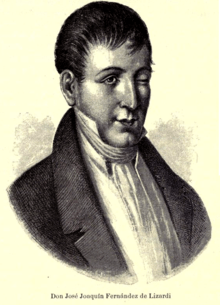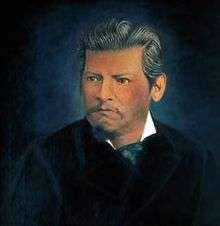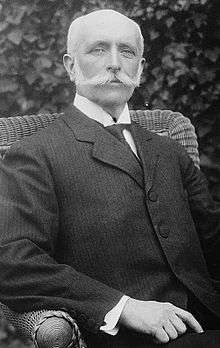Liberalism in Mexico
Liberalism in Mexico was part of a broader nineteenth-century political trend affecting Western Europe and the Americas, including the United States, that challenged entrenched power.[1]
Nineteenth-Century Liberalism
In Mexico, the most salient aspects of nineteenth-century liberalism were to create a secular state separated from the Roman Catholic Church, establish equality before the law by abolishing corporate privileges (fueros) of the church, the military, and indigenous communities. Liberals' aim was to transform Mexico into a modern secular state with a dynamic economy. Corporate privilege and the conservative elite defenders were considered stumbling blocks to the nation’s political, social, and economic progress.[2] Secular, public education was a key element in opening paths to achievement for all Mexican citizens. Schooling historically had been the domain of the church and limited to elite men, so that broadening educational access and having a secular curriculum was seen as a way to transform Mexican society.[3] The breakup of land owned by corporations, specifically the Roman Catholic Church and indigenous communities, was a crucial policy element in diminishing the power of the church and integrating Mexico’s Indians into the republic as citizens and transforming them into yeoman farmers. Unlike many liberals elsewhere, Mexican liberals did not call for limitations on executive power.[4]

Conflict between liberals and conservatives in Mexico during the nineteenth century resulted in open civil war and a foreign intervention. Liberals gained power in the 1850s embarked on a program of significant political change known as the Liberal Reform. The liberal reform was codified in the Mexican Constitution of 1857 under the leadership of Benito Juárez, a Zapotec Indian who had become a lawyer and entered politics in Oaxaca. Liberals came to power in 1854 with the ouster of conservative president Antonio López de Santa Anna.
Once in power, the liberals implemented significant changes, embodied in the Mexican Constitution of 1857. The War of the Reform (1858–61) broke out when conservatives resisted the Liberal’s sweeping political program, with conservatives defending religión y fueros ([Catholic] religion and corporate privileges). Although the liberals won this phase of the conflict, royalist conservatives sought allies abroad in France and invited Maximilian Hapsburg to become emperor of Mexico following Benito Juárez's default on the national debt, with France being one of its creditors. After five years, liberals expelled the French and executed Maximilian.
When liberal army general Porfirio Díaz, hero of the liberal struggle against the French, became Mexico’s president, he embarked on an economic development program based on foreign investment. Liberalism in the Porfiriato (1876-1911) shifted away from undermining the role of the Catholic Church and curbing the power of the military. Díaz’s supporters becoming comfortable with a strong executive, traditionally associated with conservative ideology, as a pragmatic means to achieve stability and ensure economic growth.[5]
Liberal leaders
- José María Luis Mora - Vicente Guerrero - Melchor Ocampo - Valentín Gómez Farías - Lorenzo de Zavala - José Joaquín Fernández de Lizardi - Guillermo Prieto - Juan Álvarez - Ignacio Comonfort - Benito Juárez - Miguel Lerdo de Tejada - Sebastián Lerdo de Tejada - Ignacio Manuel Altamirano - Gabino Barreda - Porfirio Díaz - José Yves Limantour - Justo Sierra - Francisco Bulnes - Francisco I. Madero - Ricardo Flores Magón
Gallery of Liberal Leaders
-

José María Luis Mora
-

Miguel Lerdo de Tejada
Further reading
- Bazant, Jan. Alienation of Church Wealth in Mexico: Social and Economic Aspects of Liberal Revolution, 1856-1875. Cambridge: Cambridge University Press 1971.
- Berry, Charles R. The Reform in Oaxaca, 1856-1876: A Microhistory of the Liberal Revolution. Lincoln: University of Nebraska Press 1981.
- Britton, John. "Liberalism" in Encyclopedia of Mexico, Chicago: Fitzroy Dearborn 1997, pp. 738–742.
- Caplan, Karen D. Indigenous Citizens: Local Liberalism in Early National Oaxaca and Yucatán. Stanford: Stanford University Press 2010.
- Chevalier, François. "Conservateurs et libéraux au Mexique. Essai de sociologie et géographie politiques de l'indepéndence a l'intervention françcaise," Cahiers d'histoire mondiale, 8(1964).
- Coatsworth, John. Growth Against Development: The Economic Impact of Railroads in Porfirian Mexico. DeKalb: Northern Illinois University Press 1980.
- Hale, Charles A. Mexican Liberalism in the Age of Mora, 1821-53. Yale University Press (1968)
- Hale, Charles A. The Transformation of Liberalism in Late Nineteenth-Century Mexico. Princeton University Press (1989)
- Jackson, Robert L. Liberals, the Church, and Indian peasants: Corporate lands and the challenge of reform in nineteenth-century Spanish America. Albuquerque : University of New Mexico Press, 1997.
- Knight, Alan. "El Liberalismo mexicano desde la reforma hasta la revolución (una interpretación)." Historia Mexicana 35(1985):59-91.
- Knowlton, Robert J. Church Property and the Mexican Reform, 1856-1910. DeKalb: Northern Illinois University Press 1976.
- Olliff, Donathan C. Reforma Mexico and the United States: A Search for Alternatives to Annexation, 1854-1861. University of Alabama Press 1981.
- Powell, T.G. El Liberalismo y el campesinado en el centro de México, 1850-1876'. Mexico City: Secretaría de Educación Pública 1974.
- Powell, T.G. "Mexican Intellectuals and the Indian Question, 1876-1911." Hispanic American Historical Review 40(1968): 19-36.
- Reyes Heroles, Jesús. El Liberalismo mexicano. 3 vols. Mexico City: UNAM 1957-61.
- Richmond, Douglas W. Conflict and carnage in Yucatán: Liberals, the Second Empire, and Maya revolutionaries, 1855-1876. Tuscaloosa, Alabama : The University of Alabama Press, 2015
- Rodríguez, Jaime. The Divine Charter: Constitutionalism and Liberalism in Nineteenth-century Mexico. Lanham, Md.: Rowman & Littlefield Publishers, 2005.
- Schoonover, Thomas David, Dollars over dominion: The triumph of liberalism in Mexican-United States relations, 1861-1867. Baton Rouge: Louisiana State University Press, 1978.
- Sinkin, Richard. The Mexican Reform, 1855-1876: A study in Liberal Nation-Building. Austin: University of Texas Press 1979.
- Tenenbaum, Barbara. The Politics of Penury: Debt and Taxes in Mexico, 1821-1856. Albuquerque: University of New Mexico Press 1986.
- Topik, Steven. "the Economic Role of the State in Liberal Regimes: Brazil and Mexico Compared, 1888–1910," in Guiding the Invisible Hand: Economic Liberalism and the State in Latin American History, Joseph L. Love and Nils Jacobsen, eds. New York 1988, 117–44.
- Thomson, Guy P. C., Patriotism, politics, and popular liberalism in nineteenth-century Mexico: Juan Francisco Lucas and the Puebla Sierra. Wilmington, Del.: Scholarly Resources, 1999.
See also
- History of Mexico
- Politics of Mexico
- History of Roman Catholicism in Mexico
- Economic history of Mexico
- La Reforma
- Reform War
- List of political parties in Mexico
- Education in Mexico
References
- ↑ John Britton, “Liberalism” in Encyclopedia of Mexico, Chicago: Fitzroy Dearborn 1997, 738.
- ↑ Charles A. Hale, Mexican Liberalism in the Age of Mora. New Haven: Yale University Press 1968, pp. 39.
- ↑ Charles A. Hale, The Transformation of Liberalism in Late Nineteenth-Century Mexico. Princeton: Princeton University Press 1989.
- ↑ Britton, "Liberalism" p. 738.
- ↑ Britton, “Liberalism” pp. 742.















